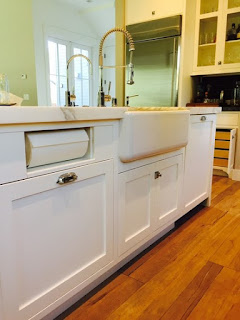Ecofriendly Kitchen: Healthier Kitchen Cabinets
by Michelle Jeresek
Earth-friendly kitchen cabinet materials and finishes offer a
host of health benefits for you and the planet. Here's a rundown
host of health benefits for you and the planet. Here's a rundown
Ecofriendly cabinets aren't just for tree huggers. Anyone wanting to improve their home’s indoor air quality or reduce the toxins they and their families are exposed to should pay careful attention to the makeup of their kitchen cabinets. Here are some handsome ecofriendly cabinet choices, along with explanations of what makes them healthier.
Formaldehyde-free
alternatives. Cabinets, and particularly
their interior boxes, are commonly constructed of particleboard, fiberboard or
plywood — all of which are often made with added urea formaldehyde binders or
glues, which release fumes.
Formaldehyde is a known carcinogen. A recent U.S. Congress bill requires that formadehyde emissions in these substrates be reduced to safer levels by 2013. Until then, err on the safe side with formaldehyde-free and low-VOC alternatives, including FSC-certified plywood, bamboo plywood and agrifiber boards, which make smart use of agricultural by-products, an annually renewable resource. Formaldehyde-free cabinets can be stylish, as this kitchen demonstrates.
Formaldehyde is a known carcinogen. A recent U.S. Congress bill requires that formadehyde emissions in these substrates be reduced to safer levels by 2013. Until then, err on the safe side with formaldehyde-free and low-VOC alternatives, including FSC-certified plywood, bamboo plywood and agrifiber boards, which make smart use of agricultural by-products, an annually renewable resource. Formaldehyde-free cabinets can be stylish, as this kitchen demonstrates.
No- and low-VOC finishes. Volatile organic compounds (VOCs) are chemical fumes emitted from some materials. For
improved indoor air quality, select finishes labeled "no-VOC" or
"low-VOC." Water-based products — with naturally fewer VOCs — are
best for a safe and durable cabinet
finish.
The quality of water-based finishes has improved in recent years as the demand for safer alternatives has increased. For added confidence of product safety, you can seek certifications from Green Seal or GreenGuard — two industry-independent organizations that give their seal of approval to building products with low chemical emissions.
This airy and light-filled kitchen used no- and low-VOC finishes as part of a whole-house approach to sustainability.
The quality of water-based finishes has improved in recent years as the demand for safer alternatives has increased. For added confidence of product safety, you can seek certifications from Green Seal or GreenGuard — two industry-independent organizations that give their seal of approval to building products with low chemical emissions.
This airy and light-filled kitchen used no- and low-VOC finishes as part of a whole-house approach to sustainability.
FSC-certified wood. Making a sustainable wood choice can be as easy as seeking certification
by the Forest Stewardship Council (FSC),
which ensures, in part, that wood products come from responsibly harvested
forests. This stylish San Francisco kitchen utilizes FSC-certified cabinet
boxes.
Salvaged wood. The most sustainable option, salvaged wood delivers richness and
personality with its history. Seek out wood with a story that you will enjoy sharing
with its admirers. This sunny kitchen is outfitted with salvaged Douglas fir
cabinets built onsite.
Wood veneer. Veneer, just a thin slice of wood adhered to a substrate, provides the
look and feel of wood without using an excessive amount of valuable hardwood.
The wenge veneer on this kitchen's cabinets proves that veneer can be just as
luxe as solid wood.
Renewable wood: bamboo. Bamboo is a rapidly renewable resource, and it's naturally stronger and
harder than most other hardwoods. In this kitchen, Plyboo, an FSC-certified
bamboo product, is set in a darker wood frame for an exotic look.
Renewable wood: Lyptus. These cabinets are made of Lyptus, a relatively new engineered product from a hybrid
eucalyptus species grown on Brazilian plantations. Lyptus touts the beneficial
traits of hardwood and reaches maturity in just 15 years, a quarter of the time
needed for typical hardwoods. The appearance is similar to that of mahogany or
cherry, with a fine grain.
Durability. Durability is an essential component of ecofriendly cabinets. Choose
well-built cabinets with robust hardware that can hold up to years of
operation, exposure to heat from the range and steam from the dishwasher. When
making decisions, do so with the expectation that your kitchen will be in place
for decades.










Nice post! thanks for sharing.
ReplyDeleteCabinet Design For Kitchen
Kitchen Remodeling Companies